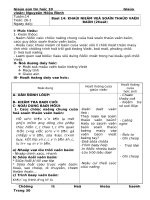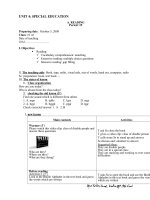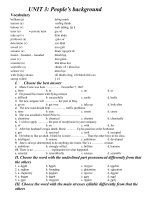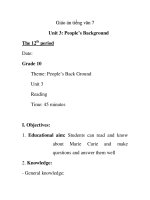- Trang chủ >>
- Sư phạm >>
- Sư phạm sử
Giáo án English 10 - Unit 3: People's background (Reading)
Bạn đang xem bản rút gọn của tài liệu. Xem và tải ngay bản đầy đủ của tài liệu tại đây (217.06 KB, 12 trang )
<span class='text_page_counter'>(1)</span>UNIT 3: PEOPLE’S BACKGROUND (READING) I. AIMS AND OBJECTIVES: 1. Language Content: - To help Students understand the back ground of Marie Curie and to provide Students with new words relating to school talks. - To help Students improve their reading skill by doing True or False exercise and Answering questions. 2. Language Function: - To enable students to grasp some new words through skimming, questioning and answering. - To help them review some structures they learnt in secondary course. 3. Educational Aim: - To educate students the realization of trying to surpass the difficulties in order to follow their dream 4. Language : - Vocabulary ( v ) harbour , take up , obtain ( a ) tragic , atomic , humanitarian (exp) with flying colours 5. Educational factor - To educate the Students to try their best to study hard and get good grade. II. TEACHER’S AND STUDENTS’ PREPARATION 1. Method Communicative Approach 2. Skills Integrated skills. (reading-speaking) 3. Techniques pairwork,groupwork,guessing,ask and answer,synonym,using picture, matching, repetition, True/false statement,… 4. Materials blackboard, chart,chalk, handouts, flash cards, picture, textbook. 5. Students’ preparation prepare the lesson at home III. PROCEDURE IN CLASS 1- Stabilization (1’) Warm up: Greeting. 2- Checking up the previous knowledge : (5ms) Asks one student to go to the board and: - Say some words with vowels /ʌ / from /a: / & gives two examples using gerunds. 3- Presentation of the new materials: Teaching steps Teacher’s activities &Time 4’ 1. Warm-up: - Give students handouts and introduce how to do the task. Match the people with their job: - Check the answers in front of class - Shows the picture & asks them who she was Leads to the new lesson.. Students’ activities. The lesson content. 1. Lead-in -Work in groups. - Answer themselves &discuss the answers with the next student. (Suggested answers: 1.a, 2.e, 3.b, 4.c, 5.d). Lop10.com. UNIT 3: PEOPLE’S BACKGROUND (READING).
<span class='text_page_counter'>(2)</span> 7’. 20’. 2. Pre- Reading -Asks the students to work in pairs asking and answering the following questions. -Has three pairs practise in front of the class . - Pre-teaches some key words & phrases to help the students master the reading passage more easily. + harbour (v) (example) +take up (v) (translation) +humanitarian(adj)(explanation) + With flying colours(exp) (translation) + mature (adj) (example) - Reads the new words and asks Students to repeat in chorus. - Calls on some Students to read again and corrects their pronunciation. - Asks Ss to check the information, read the passage. 2. Pre- Reading -Work in pairs -Practise in front of the class. 1.Can you name some scientistudents and their specializations ? 2.Have you ever heard of Marie Curie? 3.What do you know about her ? -Listen and guess the meaning of the words. -Take notes. I. Vocabulary + harbour (v) Ex: I harboured the dream of an English teacher. +take up (v) +humanitarian(adj) Ex: Her humanitarian wish come true. + With flying colours (exp) Ex: She earned a degree in Physics with flying colours + mature (adj). - Read the new words in chorus - Read the new words individually - Open books, read the passage. 3.While-Reading 3.While-Reading a/ Task 1: a/ Task 1: - Lets the Students skim the text in -Read the text in three three minutes and get some minutes and write some information about Marie Curie information about Marie Curie . - Controls the class and helps the students .. II.Reading comprehension 1/ TASK 1: (Match the words and phrases inA with their meanings in B) 1. with flying colours =very well, with a very high mark /grade 2.determine = find out exactly by making calculations - Gets students to do the Task 1 - Exchange their 3. mature and then compare with your information each other partners. = having a fully developed mind - Calls on some Students to *Suggested answers : 1c, 4. ease answer and corrects 2e, 3a, 4d, 5b. = make less severe 5. harbour = keep in the mind. b/ Task 2: - Asks Students to scan the text and work in pairs to decide whether the statements are true or false - Goes around the class and help Students if necessary - Calls on some pairs to practice in front of the class and some pairs to repeat the correct answer.. b/ Task 2: 2.TASK 2: (True/ False statements) - Scan the text -Work in pairs to practice Statements T asking and answering F -Practise in pairs in front 1.Marie went to school in Warsaw of the class 2.Her dream was to become a private tutor. - Listen to the teacher’s 3.At the Sorbornne, she studied very feedback well. 4.She married Pierre Curie in 1894 - Gets some Students to write on 5. She was the first woman professor the board. at the Sorbonne. - Corrects mistakes. * Correct the false information : 2. a private tutor a scientist 4. in 1894 1895 Lop10.com.
<span class='text_page_counter'>(3)</span> c/Task 3: - Asks Students to scan the text and work in pairs to ask and answer - Goes around the class and help Students if necessary - Gets some pairs to practise in front of their friends. - Checks and corrects mistakes. 5’. c/Task 3: - Read again and get details to complete the table - Work in pairs -Listen to the teacher’s feedback. -Discuss in groups. 4.Post-Reading -Get out the evidence from the passage to prove adjectives provided which can be used to describe Marie Curie . 1.Strong – willed : haboured the dream of a scientific career – impossible for a woman at that time. o Ambitious 2.Ambitious : keep moving up in her career . o Hard – working 3.Hard – working : difficult living conditions – worked hard 4.Intelligent : o Intelligent won the Nobel Prize . 5. Humane : o humane easing human suffering . - Calls on some Students to speak - Representatives of each group demonstrate - Feedback. 4.Post-Reading - Asks the Ss to find the evidence from the passage to prove each of these following adjectives can be used to describe Marie Curie . o Strong – willed. Homewo -Asks the students to write a short - write a short passage rk (3’) summary about Marie Curie & prepare for the next part Self evaluation:. Lop10.com. 3.TASK 3: (Answer the following questions) 1.When and where was Marie Curie born ? In Warsaw on Nov. 7, 1867. 2.What kind of student was she ? A brilliant and mature student 3.Why did she work as a private tutor ? To save money for a study tour abroad . 4. For what service was she awarded a Nobel Prize in Chemistry ? For determining the atomic weight of radium. 5. Was the prize her real joy ? Why/ Why not ? No, it wasn’t. Her real joy was “easing human suffering” *Post-Reading “ Find the evidence from the passage to prove each of these following adjectives can be used to describe Marie Curie” o Strong – willed o Ambitious o Hard – working o Intelligent o humane.
<span class='text_page_counter'>(4)</span> UNIT 3: PEOPLE’S BACKGROUND (SPEAKING) I. AIMS AND OBJECTIVES: 1. Language Content: - To help students tell about somebody’s background . 2. Language Function - To motivate the students to discuss what questions they can ask when they want to know about somebody’s background. - To help students review and use some structures they learnt in secondary course. 3. Educational Aim -To educate the students to take care of and respect their classmates . 4. Language - Vocabulary : education , appearance , experience , hobby - Structure : kinds of the questions . 5. Educational factor - To help the students to have a good & serious attitude to their studies. II. TEACHER’S AND STUDENTS’ PREPARATION 1. Method Communicative Approach 2. Skills Speaking 3. Techniques question-answer ,interview, substitution, pair work, group work 4. Materials textbooks, cassette player, chalks, board 5. Students’ preparation prepare the lesson at home III. PROCEDURE IN CLASS 1- Stabilization (1’) Warm up: Greeting. 2- Checking up the previous knowledge : (5’) - Calls on one student to the blackboard and asks them to say something about Marie Curie * Questions: (1) When and where was Marie Curie born ? (2) What kind of student was she ? (3) Why did she work as a private tutor ? (4) For what service was she awarded a Nobel Prize in Chemistry ? (5) Was the prize her real joy ? Why/ Why not ? * Suggested answers: 1. In Warsaw on Nov. 7, 1867. 2. A brilliant and mature student 3. To save money for a study tour abroad . 4. For determining the atomic weight of radium. 5. No, it wasn’t. Her real joy was “easing human suffering” - Listen and gives remarks, marks 3- Presentation of the new materials: Teaching steps Teacher’s activities Students’ activities The lesson content &Time 4’ 1. Lead-in 1. Lead-in UNIT 3: -Asks the students some questions PEOPLE’S BACKGROUND - Listen and answer the about Marie Curie , about her husband questions. (SPEAKING) ,… _ Asks them how they can know about the information. Leads to the new lesson . 7’ 2. Pre- speaking : 2. Pre- speaking : 1. Task1 : - Helps the students revise how to -Listen and answer a. Notes : make personal questions +When and where were you born? - Ask the students some personal -Listen & give answers +How long have you been living here? questions - Read in three minutes and +Can you tell me about your parents? - Asks the Students to read the items decide which of them can +What does your father/mother do? +How many brothers and sisters have in their books in three minutes and to represent somebody’s you got? How old are they? What do decide which of them can represent background. somebody’s background they do? - Controls the class and helps the Ss . +What subject do you like best? Lop10.com.
<span class='text_page_counter'>(5)</span> - Asks the Students to exchange their ideas with their classmates. - Corrects & help the students have suitable answers : family, hobby,education, dislikes.. 20’. 5’. 3. While - speaking - Guides the students how to do this task, gives them some special expressions to help them speak more naturally. -Asks students to practise in pairs.. - Exchange their ideas each other . - Listen.. 3. While - speaking - Listen carefully. +Which primary school and junior high school did you go to? +What do you like and dislike? +What’s your hobby? b. Suggested answers : (Items can be use to tell about somebody’s background ) Family hobby Education dislikes. 2. Task 2: ( INTERVIEW) * Use the cue given : o Greeting o Date of birth - Work in pair – one plays the o Home o Parents role of journalist, the other will answer all the questions o Brother(s) - Goes around and helps students if related o sister(s) necessary. - Practise in front of class o Primary school o Secondary school o Schoolwork o Favourite subjects o Experience o Thanking * Suggested questions : o What’s your birthday ? o Where were you born ? o Where do you live ? o Could you tell me about your parents ? 4. Post- speaking: 4. Post- speaking: 3. Task3: - Asks the class to work in groups, - Work in groups . Talk “Talk about the person they have learnt and to talk about the person they have about the person they from the interview” learnt from the interview. have learnt from their - Listen to them and correct their interview. - Listen . mistakes.. Homework - Asks each of the Ss to write a short 3’ passage about individual resume prepare the next part ( LISTENING) Self evaluation :. - write a short passage. Lop10.com.
<span class='text_page_counter'>(6)</span> UNIT 3: PEOPLE’S BACKGROUND (LISTENING) I. AIMS AND OBJECTIVES: 1. Language Content: - To help students get information about Sally , an Olympic champion. -To help the students to listen to short conversations for general or specific information 2. Language Function: - To motivate students to prove their ideas after listening the conversations from the tape – record. 3. Educational Aim: - To educate students to interest sport and to keep fit . 4. Language : - Vocabulary champion (n) , romantic (adj), participate(v) , diploma (n) 5. Educational factor - To teach the students the love for sports & keeping fit II. TEACHER’S AND STUDENTS’ PREPARATION 1. Method Communicative Approach 2. Skills Integrated skills. (Listening-speaking) 3. Techniques pair work,True-false statements, filling gap, using pictures 4. Materials textbooks, cassette player, chalks, board 5. Students’ preparation prepare the lesson at home III. PROCEDURE IN CLASS 1- Stabilization (1’) Warm up: Greeting. 2- Checking up the previous knowledge : (5’) -Calls on two students to the blackboard and asks them to make a conversation using the cues given : o Greeting o Primary school o Date of birth o Secondary school o Home o Schoolwork o Parents o Favourite subjects o Brother(s) o Experience o sister(s) o Thanking -Listens and gives remarks & marks 3- Presentation of the new materials: Teaching steps &Time 4’. 7’. Teacher’s activities. Students’ activities. 1. Lead-in -Shows the pictures of some famous people and asks the students to tell about their names & something they know about them. Leads to the lesson. 1. Lead-in Work in groups & give the answer to the teacher.. 2.Pre- Listening -Gets the students to discuss in pairs -Explains these new words to the students & helps them pronounce exactly. + Olympic Champion + sports teacher + teacher’s diploma +love story + romantic. 2.Pre- Listening - Work in pairs (1). Do you know any Olympic Champion? (2).What do you want to know about an Olympic Champion?. Lop10.com. The lesson content UNIT 3: PEOPLE’S BACKGROUND (LISTENING) I. Before you read: * Work in pairs (1). Do you know any Olympic Champion? (2).What do you want to know about an Olympic Champion? *Listen & repeat : + Olympic Champion + sports teacher + teacher’s diploma +love story + romantic.
<span class='text_page_counter'>(7)</span> 20’. 5’. 3. While- listening a/ Task 1: - Sets situation: “Bob and Sally are in the conversation, they are talking about their family, career , and some things they like or dislike” - Plays the tape three times & asks the Students to listen what they are talking and give out their ideas about the statements - Asks the Students to exchange their information with their classmates. -Plays the tape one more & helps the students check their listening. b/ Task 2: - Gives the requirement and guides the Ss to do Task 2 . - Asks the class to work in groups, and to discuss about what they heard from the conversation. - Lets the Ss listen to the tape and fill in the gaps . - Plays the tape again and asks them to check their works . 4.Post- listening - Asks the Ss to work in groups : question and answer about Sally. -Helps the students if necessary.. Homework -Asks the students to prepare the (3’) next part ( Writing). 3. While- listening a/ Task 1: - Listen to the teacher’s situation. - Listen what they are talking and say : T / F for the statements in Task 1 . - pair-work . then say their ideas . -Listen to the tape & check their guessing -Listen to the tape again. b/ Task 2: - Listen. - Work in groups .. II. Listening : a/ Task 1: 1. T 2. T 3. F “I don’t have much time” 4. T 5. F “I want to be a sport teacher”. b/ Task 2: (Listen & fill in the blanks) 1. general education 2. lives / family 3. different/ swimming 4. love stories 5. teacher’s diploma. - Listen and fill in the gaps . - Listen to the tape again and check their works . 4.Post- listening -Work in pairs basing on the c/ Task 3: guidelines . (Ask and answer about Sally). -Listen to the teacher’s instruction & do it at home.. * Self-evaluation:. Lop10.com.
<span class='text_page_counter'>(8)</span> UNIT 3: PEOPLE’S BACKGROUND (WRITING) I. AIMS AND OBJECTIVES: 1. Language Content: - To help students write a passage to represent somebody’ curriculum - vitae . 2. Language Function - To help the students review some structures and vocabulary learnt. - To motivate students to improve their writing skills . 3. Educational Aim -To educate the students to take care of and respect their classmates . 4. Language - Vocabulary: curriculum – vitae (n) , previous (a) , attend (v) 5. Educational factor - To educate students to interest the friends around them . II. TEACHER’S AND STUDENTS’ PREPARATION 1. Method Communicative Approach 2. Skills writing & speaking 3. Techniques Explanation, pairwork, groupwork 4. Materials textbooks , chalks, sub-board 5. Students’ preparation prepare the lesson at home III. PROCEDURE IN CLASS 1- Stabilization (1’) Warm up: Greeting. Checking absence: Who’s absent today? 2- Checking up the previous knowledge : (5’) - Calls on one student to the blackboard & asks the some questions about Marie Curie 3- Presentation of the new materials: Teaching steps Teacher’s activities Students’ activities The lesson content &Time 4’ 1. Lead-in 1. Lead-in Gives some jumbled sentences Work in groups trying to make UNIT 3: and asks Students to reorder the meaningful sentences * Suggested answers : PEOPLE’S BACKGROUND words to make meaningful sentences. 1. He was born on December (WRITING) 1. was born, Sir Isaac Newton, 25, 1642, in Lincolnshire, 1642, December 25, on, England, England. in, Lincolnshire. 2. He was brought home from school to run the farm 2. home from school, was, he, brought,run the farm,1656,to, in. in 1656. -Asks students where they get - Answer the teacher’s these information of famous questions ( in books, persons magazines,newspapers, from Leads to the lesson. an interview…) 7’ 2.Pre- Writing 2.Pre- Writing I. SOME NOTES : - Introduces Mr. Brown’s -Listens and takes notes. +Curriculum-vitae curriculum–vitae, and explains (a form with details about somebody’s what details Ss can read in a past education and job). individual resume. - Answer the questions if + previous = former (adj) - Explains some difficult words & possible + attend (v) Work in pairs & answer the + travel agency (n) phrases : questions +Curriculum-vitae (a form with details about somebody’s past education and job). + previous = former (adj) + attend (v) + travel agency (n) -Give further information. Lop10.com.
<span class='text_page_counter'>(9)</span> -Asks students to give some further information about C.V 3. While- Writing Task 2: - Introduces how to practise task 2 & gives them some special expressions to help them speak more naturally. - Asks students to work in pairs asking and answering for the information about the partner’s parent - Help students if necessary. -Asks students to tick their answer’s on the blackboard & gives feedback. 3. While- Writing Task 2: - Pay attention to the requirement of Task 2. II. TASKS: Task 2: (Complete the blanks). - Work in pairs. - Ask for help - Show their form before class.. 5’. 4. Post- writing - Asks the Ss to write a short paragraph about their partner’s parent .(task 3) - Asks the Ss to read their writings and check whether the information is correct. -Tells students to look at the board and comment on their answer. -Corrects the mistakes If time allowed , call some pairs to act out the interview in the front of class.. HomeworkConsolidation 4’ 4’. 15’. about C.V. 4. Post- writing 3. Task3: - Work in their groups and (Write a paragraph about your write down on the paper-board partner’s parent) -Work in groups. - Base on their friends ‘forms, tell some things about them such as: place of birth, occupation, etc…. -Asks the students to practise -Work in pairs asking and answering about themselves in front of the class. - Asks the students to write a -Listen to the teacher’s paragraph about their parents . instruction & do it at home. -Asks the students to prepare the next part ( Language Focus) * Self-evaluation:. Lop10.com.
<span class='text_page_counter'>(10)</span> UNIT 3: PEOPLE’S BACKGROUND (LANGUAGE FOCUS) I. AIMS AND OBJECTIVES: 1. Language Content: - To help students distinguish and pronounce the two vowel sounds / e / and / æ / in single words and meaningful expressions . - To help the students review how to use and past perfect tenses . 2. Language Function - To help the students practise pronounce the two vowel sounds /e/ and /æ/ in some words and sentences . - To enable the students to distinguish the use of the past perfect and simple past tense - To motivate students to do exercises , using simple past and past perfect tenses . 3. Educational Aim - To educate students to interest the language focus through their lesson . 4. Language - Pronunciation: Vowel sounds : / e / and / æ / - Structures : + the past perfect tense + the past perfect tense vs. the past simple 5. Educational factor - By the end of the lesson, the students can distinguish the use of the past perfect and simple past tense II. TEACHER’S AND STUDENTS’ PREPARATION 1. Method Communicative Approach 2. Skills Speaking, writing 3. Techniques Explanation, Listening and repeating, pair-work, group-work,… 4. Materials textbooks , chalks, sub-board 5. Students’ preparation Review the grammar points and consult the grammar books III. PROCEDURE IN CLASS 1- Stabilization (1’) Warm up: Greeting. 2- Checking up the previous knowledge : (4’) - Asks two students to go to the board and make a small conversation using the cues given : - Listens & gives remarks , marks 3- Presentation of the new materials: Teaching steps Teacher’s activities Students’ activities The lesson content &Time 4’ * A. PRONOUNCIATION: 1. Lead-in 1. Lead-in - Gives some words and asks the -Work in groups & try to UNIT 3: PEOPLE’S sts to rearrange them into 2 rearrange the words into BACKGROUND (LANGUAGE different columns:“ end, ever, different columns. FOCUS) enlarge, mean, break, bread, I/ PRONUNCIATION: check, pen, expensive” -Asks students to say the reason - Say the reason. /e/ /æ/ for their arrangement. men Leads to the new lesson. -Listen to the teacher. bed 2. Pre-practice: 2. Pre-practice: said - Reads the words in textbook - Listen and repeat. First in pen met once and tells Sts the differences chorus, then individually send man between two sounds / e / and / æ / bad and how to pronounce them. - Reads one by one and has Sts sad repeat. pan - Corrects mistakes. mat sand 3. Controlled- practice: - Has Sts read the sentences in the 3.Controlled- practice: * Practise these sentences : book after listening to the teacher 1.The fat man has a red pen. read once. - Pair-work 2.This handbag will be sent to Helen.. Lop10.com.
<span class='text_page_counter'>(11)</span> - Goes around the class to help Sts if necessary. 4. Free- practice: - Has Sts list some more words 4. Free- practice: - Practise in groups with these sounds. * B. GRAMMAR: 1. Lead-in: * B. GRAMMAR: -Asks students what they did at 1. Lead-in: 8p.m yesterday evening , -Listen and answer the What they had done before that teacher’s questions time,… Says sth & leads in the lesson . 2. Pre- practice: -Gives some examples and asks 2. Pre- practice: students to remind about the past -Pay attention to examples & perfect tense revise how to use the past -Helps students to revise how to use perfect tense past perfect and past simple tense & helps students know the differences between these two tenses. 3. Controlled – practice: 3.Controlled – practice : (1). Exercise 1: (1). Exercise 1: -Asks sts to work in pairs to make Work in pairs questions . One asks and the other answers and vice versa - Calls on Practice some pairs to practice . - Corrects mistakes. Listen. (2)Exercise 2: -Asks the sts put the verbs in the correct forms using the simple past and past perfect tense. -Calls on some sts to write the answers on the board . -Corrects the mistakes . (3)Exercise 3: -Divides the class into four groups & asks them to practise finding the mistakes in the passage given. The quickest groups will be the winner. - Calls on the representative of the winning group to demonstrate their answers. - Corrects the mistakes . 4. Free- practice: -Asks students to give some more examples using the past perfect. 3.Sam said apples were very expensive then. 4.There’re ten pans on the shelf. 5.Ben sat on a bench with a yellow cat. 6.Ann never gets bad marks in French. II. GRAMMAR : 1. Past perfect tense : * Form: HAD + PP *Ex: I had finished my homework before 11o’clock last night. 2. Past perfect vs. past simple: Ex: I had had dinner before you came to see me yesterday afternoon.. III. EXERCISES : 1. Exercise 1: (The past perfect tense) *Suggested answers: 1. had broken 2. had done 3. had met 4. hadn’t turned off 5. had ever seen 6. had been 7. had left 8. had moved 9. hadn’t seen 10. had broken in (2)Exercise 2: (2)Exercise 2: Work in groups (Put the verbs in brackets in the past simple or the past perfect tense) *Suggested answers: 1. had just finished , came -Write their answer on the bb. 2. had seldom travelled , went -Listen to the teacher. 3. went , had already taken 4. Did…manage,had…gone , got . 5. had just got , phoned,had been (3)Exercise 3: Work in groups (3)Exercise 3: *Suggested answers: 1. (sentence 1) had climbed climbed 2. (sentence 3) -The representative of the had turned turned 3. (sentence 5) winner demonstrate their had called out called out answers -Listen 4. (sentence 7) 4. Free- practice: had heard heard. Lop10.com.
<span class='text_page_counter'>(12)</span> tense.. -Work in groups. -Asks students to rewritten all the exercises into their exercise notebooks. -Guides the sts to prepare TEST YOURSELF A. -Listen to the teacher’s instruction & do it at home.. Lop10.com. 5. (sentence 9) went had already gone.
<span class='text_page_counter'>(13)</span>









